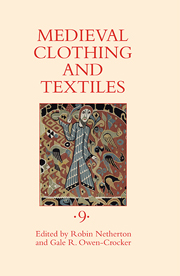Book contents
- Frontmatter
- Contents
- Illustrations
- Tables
- Contributors
- Preface
- 1 Bridal Gifts in Medieval Bari
- 2 The Marriage of the Year (1028)
- 3 Clothing as Currency in Pre-Norman Ireland?
- 4 Cistercian Clothing and Its Production at Beaulieu Abbey, 1269–70
- 5 Clothing and Textile Materials in Medieval Sweden and Norway
- 6 The Iconography of Dagged Clothing and Its Reception by Moralist Writers
- 7 Domestic Painted Cloths in Sixteenth-Century England: Imagery, Placement, and Ownership
- Recent Books of Interest
- Contents of Previous Volumes
Preface
Published online by Cambridge University Press: 05 July 2013
- Frontmatter
- Contents
- Illustrations
- Tables
- Contributors
- Preface
- 1 Bridal Gifts in Medieval Bari
- 2 The Marriage of the Year (1028)
- 3 Clothing as Currency in Pre-Norman Ireland?
- 4 Cistercian Clothing and Its Production at Beaulieu Abbey, 1269–70
- 5 Clothing and Textile Materials in Medieval Sweden and Norway
- 6 The Iconography of Dagged Clothing and Its Reception by Moralist Writers
- 7 Domestic Painted Cloths in Sixteenth-Century England: Imagery, Placement, and Ownership
- Recent Books of Interest
- Contents of Previous Volumes
Summary
Volume 9 of Medieval Clothing and Textiles reflects the eclecticism of our subject, ranging from Scandinavia through England and Ireland to southern Italy, and addressing textiles, furs, finished garments, and soft furnishings. Its sources are chiefly nonliterary texts and also art.
Antonietta Amati Canta examines the evidence for garments, dress accessories, and personal jewelry among the dowry provisions in marriage contracts of the multicultural city of Bari. In a companion article, Lucia Sinisi discusses one early-eleventh-century cartula, uniquely illustrated with a miniature of the bride and groom in what may have been their bridal finery. Trousseaux feature again, along with wills, inventories, bills of sale, and magistrate's records, in Eva Andersson's investigation of the consumption of textiles, furs, and clothing in medieval Sweden and Norway.
English and French moralistic writers of the fourteenth and fifteenth centuries abhorred the fashion of dagged garments; John Friedman investigates the development of dagging to show how its associations with religious or ethnic alterity, fools, and entertainers both contributed to and reflected the hostility of the moralists when dagging became popular in western Europe. Mark Zumbuhl teases out references in law codes, records of property transactions, hagiography, The Book of Rights, and chronicles to deduce that in medieval Ireland garments could be used as grants, pledges, stipends, and payments of fines or forfeitures.
Susan James uses wills and inventories as well as records of trade and manufacture to illuminate the subject of the painted wall hangings that were ubiquitous soft furnishings in sixteenth-century England, examining their functions, the images depicted on them, and their relative value.
- Type
- Chapter
- Information
- Medieval Clothing and Textiles 9 , pp. xi - xiiPublisher: Boydell & BrewerPrint publication year: 2013



